Vibrant colors, handcrafted accents, and earthy textures set the tone for patios inspired by Mexican design. This style effortlessly merges tradition with warmth—welcoming you into a space filled with terracotta tiles, woven textiles, and pops of cobalt, coral, and mustard. Whether you’re curating a quiet courtyard or energizing a larger backyard, these patios celebrate outdoor living with personality and soul. Ideal for year-round entertaining or daily unwinding, this aesthetic thrives on authenticity and charm. The following ideas showcase how to bring this festive spirit into your own backyard, using accessible elements that channel rustic beauty and cultural richness with ease.
Talavera Tile-Faced Accent Wall
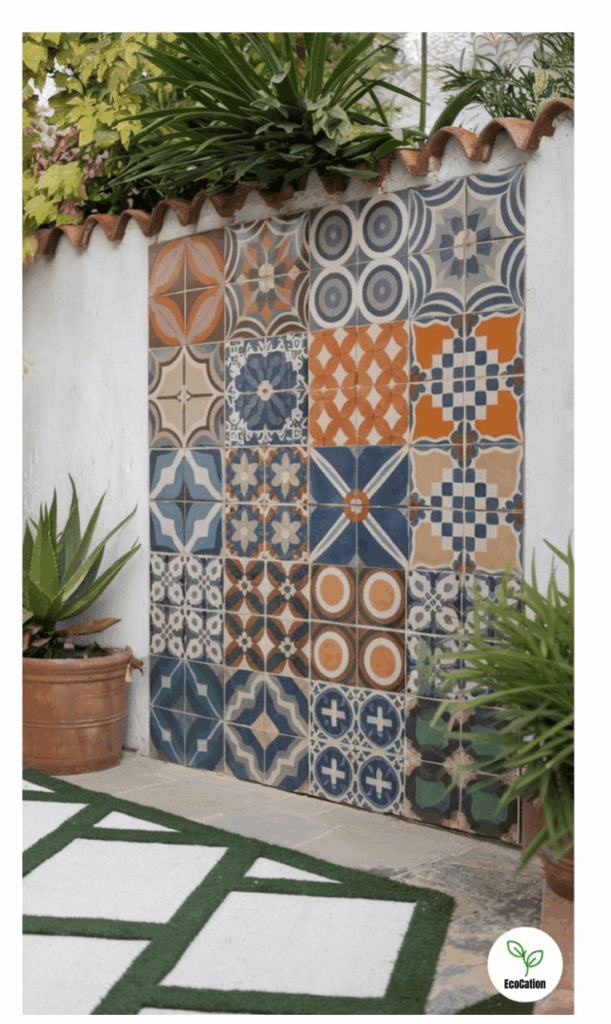
Vibrant detailing becomes the soul of a patio when Talavera tiles line an accent wall. These hand-painted ceramics offer intricate patterns and bold hues, often in deep blues, sun-drenched yellows, and warm terracottas. They instantly inject character and cultural richness while protecting exterior surfaces from sun and moisture. For patios lacking natural focal points, this wall style becomes a visual magnet, ideal for anchoring benches, fountains, or dining areas. When paired with rustic lighting or iron fixtures, the wall’s vibrancy becomes amplified. The fusion of texture and pattern feels intentional and rooted in traditional Mexican design, offering both aesthetic flair and practicality. Homeowners with limited space can use this element to bring dynamic personality without cluttering the floor plan. Whether full-wall or half-height, the surface commands attention without overwhelming. For DIY lovers, adhesive-backed replicas provide a more accessible route to achieving the look. Complementing the wall with terracotta pots or woven textiles nearby helps reinforce the cohesive feel. This accent solution balances tradition and artistry, making it highly adaptable across patios of various sizes. From shaded courtyards to sunlit decks, Talavera tile-faced walls remain a timeless way to spotlight Mexican flair with minimal effort.
Color-Pop Wrought-Iron Seating Nooks
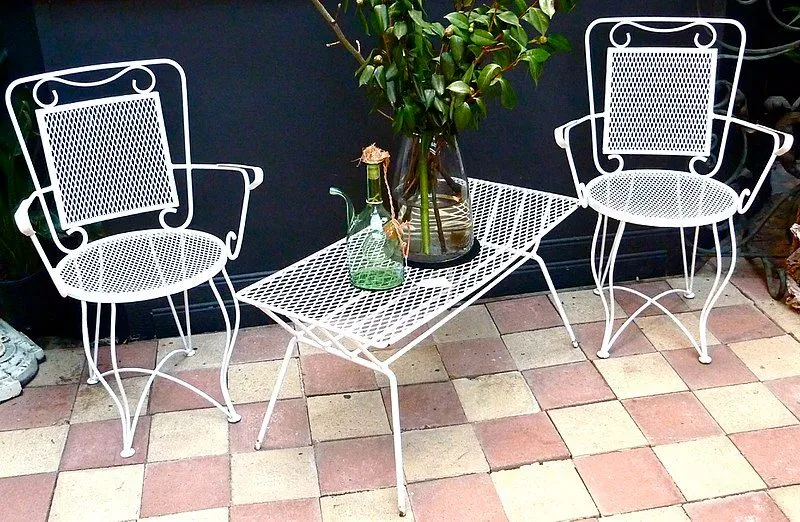
Inviting seating corners with colorful wrought-iron chairs breathe life into underused patio areas. The beauty lies in the bold palette—think cobalt blue, vibrant coral, lime green, and sunflower yellow—each hue standing out against natural stone, terracotta floors, or stucco walls. These cozy nooks are perfect for morning coffee or sunset chats, especially when paired with matching mosaic-topped side tables. Wrought iron, known for its durability, weathers beautifully outdoors while offering endless design possibilities with intricate scrollwork or geometric patterns. Many homeowners layer on patterned seat cushions in serape or Otomi prints to soften the metal’s firmness and add comfort. Placing these seating spots near entryways, garden edges, or even small corners allows better space utilization without large furniture footprints. Potted cacti or clay planters beside the chairs further strengthen the Mexican aesthetic while subtly blending color and greenery. Overhead string lights or hanging papel picado elevate the ambiance for evening use. Whether repurposed vintage finds or newly powder-coated designs, these seating clusters turn forgotten areas into conversation-friendly focal points. As a bonus, the compact size means easy rearrangement depending on the season or event. These vibrant iron accents are equal parts functional and artistic—an essential in any Mexican patio.
Mixed Mosaic Pavers with Terracotta Hues
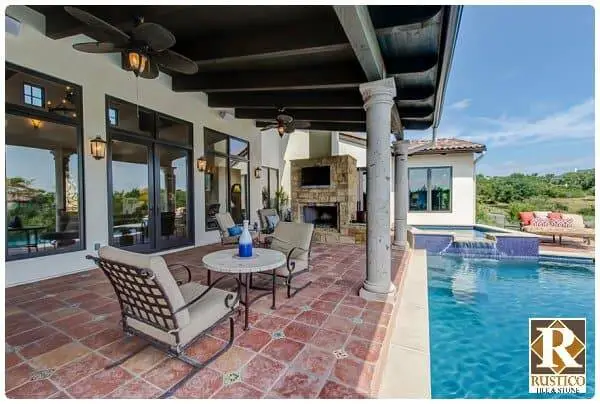
Visual rhythm emerges when variously shaped and toned mosaic pavers create the walking foundation of a Mexican patio. Each paver, often a blend of terracotta, deep red, soft beige, and charcoal gray, works like a brushstroke to form a canvas underfoot. Irregular sizing enhances the artisanal charm while naturally guiding the eye through lounging zones or garden paths. Unlike uniform concrete slabs, this layout embraces imperfection and color contrast, making every installation one-of-a-kind. Homeowners drawn to tactile, handmade design often find mosaic pavers more expressive, especially when framed by gravel joints or pebbled borders. These stone mosaics are ideal for patios with a mix of zones—lounging, dining, and planting beds—as they help define space without walls or dividers. Even compact patios benefit from this paver style, offering both grip and elegance underfoot. Sealing the stones boosts color vibrancy and durability, particularly in climates with seasonal rainfall. Planting creeping thyme or moss between wider paver joints adds softness and a living touch to the otherwise hardscape-driven design. For a more structured effect, mixing geometric tile cuts can modernize the aesthetic. Mosaic pavers with terracotta hues fuse practicality with flair, keeping the patio grounded in warmth and heritage.
Adobe-Style Stucco Walls & Arched Openings
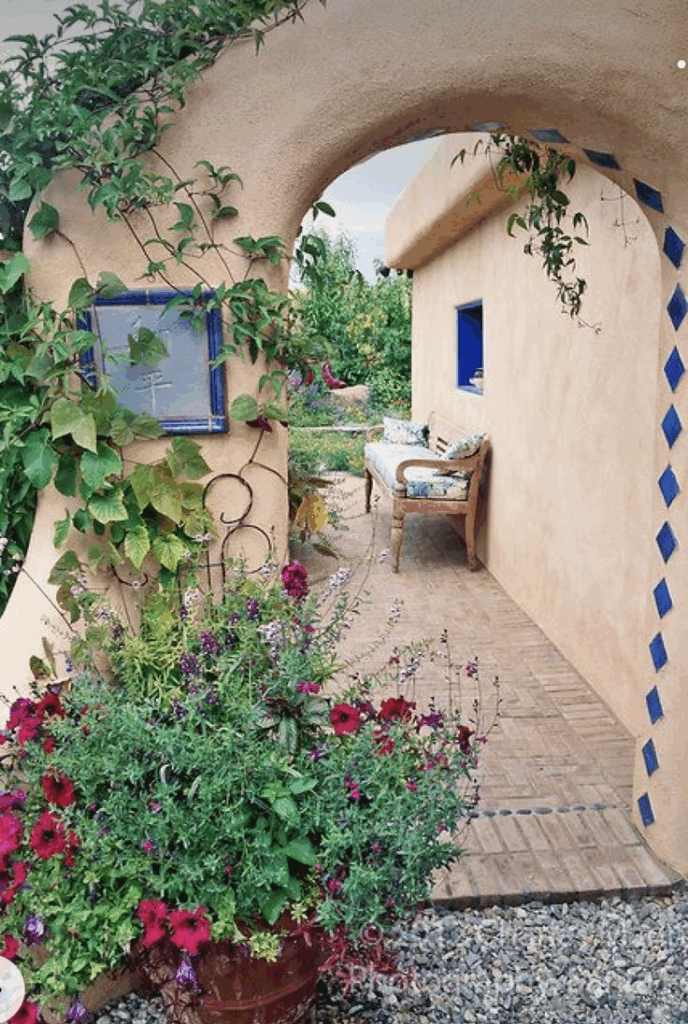
Texture and architectural character take center stage with stucco walls and classic arched openings. These adobe-style elements nod to centuries-old Mexican building traditions while providing function and beauty. The matte, earthen finish of stucco reflects sunlight softly and works as a breathable, heat-managing surface—ideal for hot climates. Arches bring graceful flow to entry points, garden frames, or alcove transitions, creating a sense of rhythm across the patio. Whether structural or ornamental, they lend authenticity that resonates with Mediterranean and Southwestern influences. Many homeowners use these walls as blank backdrops for vibrant accents—such as hand-painted planters or woven wall hangings. Stucco can be pigmented in warm tones like burnt orange, peach, or sand to amplify desert-style themes. Garden lighting or sconces mounted on these surfaces further define the space as the sun sets. Maintenance is low, requiring only periodic patching and lime wash refreshes to retain integrity. Arched niches can also function as built-in shelves or housing for potted succulents and lanterns. Combining textured stucco with curved silhouettes instantly sets a relaxed tone, turning even modest patios into havens of cultural identity and warmth. These elements deliver timeless visual appeal with long-lasting durability.
Ladder-Topped Pergola Draped with Bougainvillea
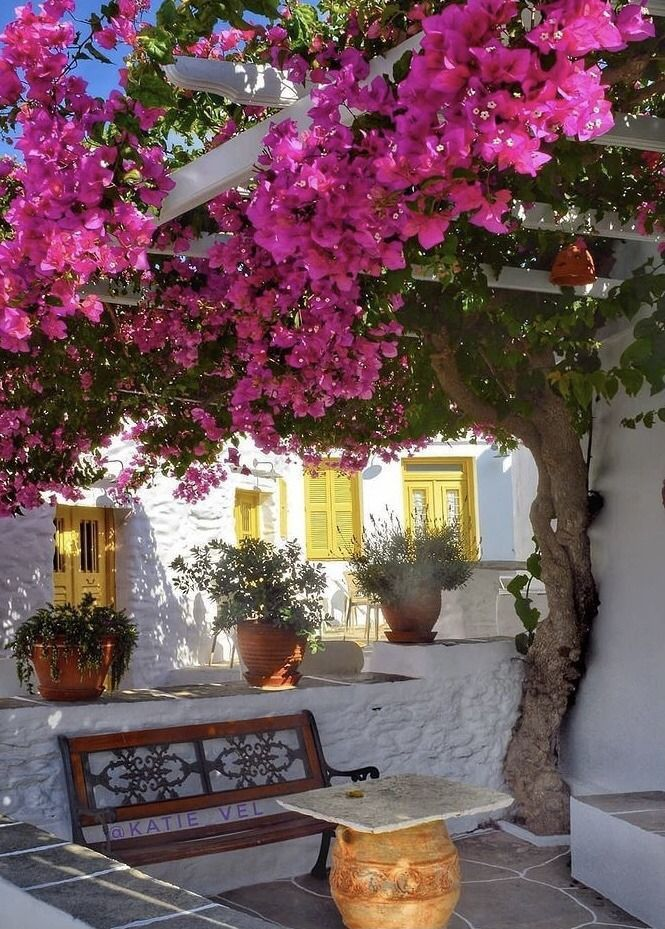
Architectural layering reaches new heights with pergolas topped by ladders and entwined with blooming bougainvillea. This patio structure blends rustic craftsmanship with organic softness, offering both shade and visual impact. The use of wooden ladders—either reclaimed or purpose-built—as the roofing slats introduces linear interest while allowing light to filter gently below. Bougainvillea, known for its vivid magenta, coral, or purple blossoms, weaves through the wooden rungs over time, forming a living canopy. These blooms not only draw the eye upward but also provide pollinator support for butterflies and hummingbirds. When placed above an outdoor dining area or lounge setup, this pergola transforms the entire experience. The filtered light softens midday glare without fully enclosing the space. Anchoring the posts with clay planters or stone bases stabilizes the frame while enhancing its visual grounding. Homeowners can also tie in additional texture by hanging lanterns or ceramic chimes from the beams. With each passing season, the pergola matures in richness, as vines thicken and blooms cycle in and out. This design balances hard and soft materials, delivering a romantic, functional structure rooted in heritage and designed for lasting beauty.
Sunken Firepit Surrounded by Colorful Cushions
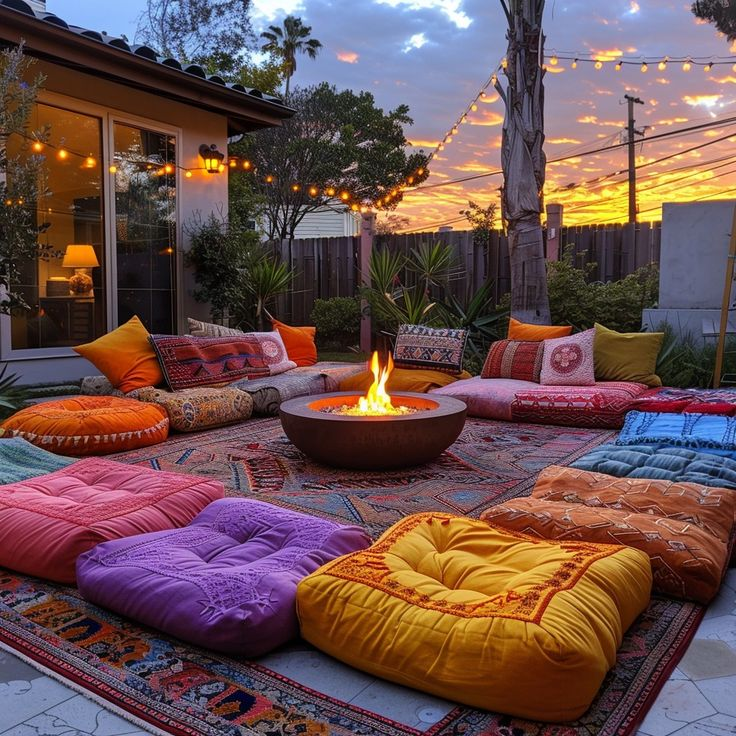
Depth and intimacy take shape around recessed firepit zones surrounded by color-rich cushions. Sinking the fire feature just below surface level offers both visual intrigue and wind protection, while the circular seating design invites gathering. Vibrant cushion arrangements—featuring shades like mustard, turquoise, ruby, and marigold—draw from traditional Mexican textiles, making the area feel celebratory and soulful. Homeowners often choose kilim or Otomi-style covers to echo artisanal patterns and stories. This setup proves especially effective in open patios where defining a social core is needed without obstructive barriers. The lowered floor helps contain heat, which makes the space cozier during chillier evenings. Stone or brickwork around the pit enhances rustic appeal while ensuring safety. Surrounding this sunken nook with gravel, pavers, or tiles can aid drainage and visual separation. Lightweight tables or ceramic stools placed nearby support drinks, snacks, or decorative touches. When combined with string lights overhead and subtle landscape uplighting, the atmosphere turns magical after dark. This type of firepit installation encourages longer stays outdoors, encouraging storytelling, laughter, and warmth—both literal and cultural. It’s a layout built for community connection, rooted in tradition and sensory richness.
Clay Chiminea with Custom Painted Patterns

Visual storytelling comes alive through clay chimineas with custom hand-painted surfaces. These freestanding outdoor fireplaces, often bulbous in shape with a flared mouth, serve as both heating elements and design statements. Custom paintwork adds personality, turning the clay form into a canvas of floral, folkloric, or geometric motifs. Shades of teal, ochre, cobalt, or crimson frequently echo Mexico’s artistic heritage. While chimineas were originally used for practical heat distribution and cooking, their modern iterations focus more on ambience and style. Placing one in a patio corner or central lounging spot makes it a cozy focal point, ideal for smaller patios where firepits aren’t feasible. Clay retains and radiates heat efficiently, keeping the surrounding area warm even after flames die down. Smoke rises through the chimney, minimizing discomfort for seated guests. Homeowners may flank their chiminea with low stools, potted herbs, or woven mats to complete the scene. For seasonal variation, the paintwork can reflect holidays or local inspirations. Safety is key—placing it on a stone pad or brick surface prevents cracking or fire hazards. With the right styling, a painted chiminea becomes more than a source of heat—it’s a storytelling object that enlivens the patio with artful warmth.
Vertical Succulent & Cactus Green Wall

Vertical gardens full of succulents and cacti redefine how walls can breathe life into compact patios. Mounted wooden frames, recycled pallets, or tiered metal grids act as supports for small planters, creating an ever-changing botanical tapestry. These displays thrive in sunny, dry climates and require minimal watering, making them perfect for low-maintenance patios. Succulents like echeveria, jade, and sedum pair effortlessly with upright cacti such as euphorbia or golden barrel. The palette of greens, dusty blues, and occasional burgundy tips adds texture without overwhelming the eye. This feature functions as both art and living decor, breaking up empty wall space while maximizing planting without consuming ground area. Ideal behind a seating bench or alongside entryways, it boosts privacy and provides natural insulation. Many homeowners use colorful pots or Talavera tiles as visual accents within the vertical array. Night lighting subtly tucked behind planters adds depth and ambiance after dusk. With thoughtful planning, the green wall can also rotate seasonally, allowing for fresh visual interest throughout the year. In Mexican-inspired patios, these vertical ecosystems blend function, charm, and ecological mindfulness in one bold statement.
Hand-Painted Planter Clusters on Corrugated Shelves

Clustered hand-painted planters lined up across corrugated metal shelving form a playful and artistic moment on any patio wall. Each vessel tells a story—some adorned with floral flourishes, others with folkloric faces or geometric symbols—set against the raw industrial edge of the metal backdrop. This contrast between the delicate brushstrokes and rugged texture adds unexpected charm while enhancing visual depth. Using mismatched shelves in varied lengths or heights can provide a casual, organic feel that fits the eclectic nature of Mexican patio aesthetics. These shelves can be affixed to fencing, stucco, or even brick, making them versatile for different layouts. Smaller succulents, herbs, or flowering plants bring a lively pop of greenery, especially when potted in terracotta or vibrantly glazed containers. The display can also shift with the seasons, from marigolds and cacti to ornamental peppers or holiday decor. This solution works particularly well for tight patios where ground space is limited. It draws the eye upward, enriching vertical zones that might otherwise go unused. Easy to install and endlessly customizable, these planter clusters become an extension of the homeowner’s personality—colorful, spirited, and undeniably Mexican.
Serape Stripe Outdoor Rugs on Brick Floors
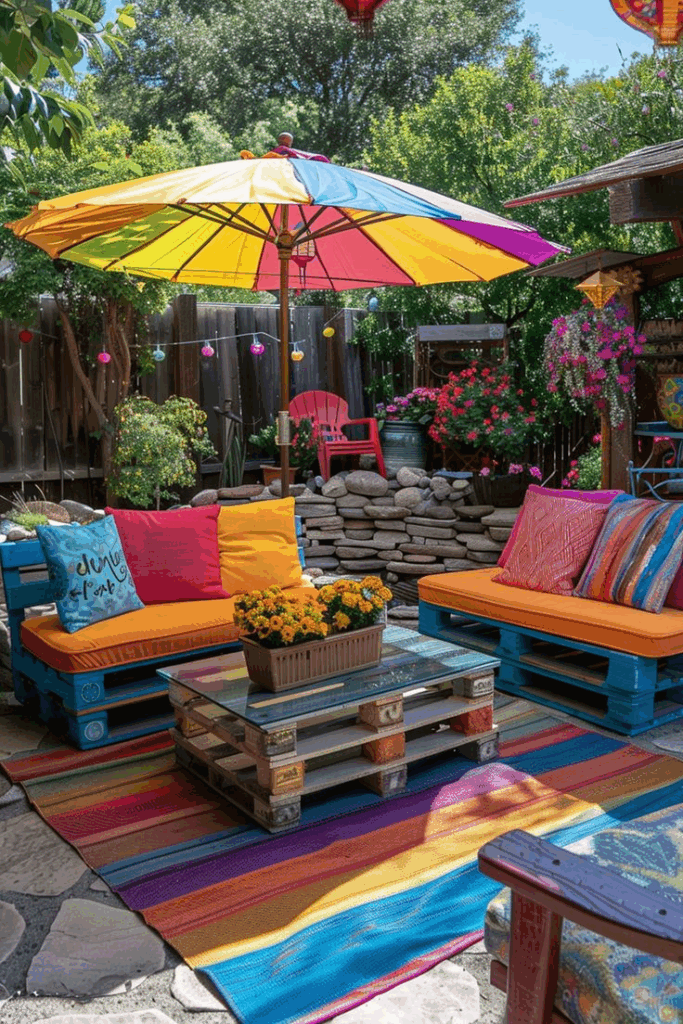
Bold patterns underfoot define the mood when serape stripe rugs grace a patio’s brick foundation. These rugs often feature bands of red, orange, teal, and deep indigo woven into dynamic linear compositions. Their cultural origin lies in traditional Mexican blankets, now reimagined for outdoor living spaces. On top of aged brick floors, the vibrant textile injects a burst of energy and softens the otherwise firm surface. These rugs help delineate seating or dining zones, especially in open-plan patios, offering both warmth and grounding. Look for weather-resistant or reversible versions to extend lifespan and resist fading from sun or rain. Layering multiple sizes or aligning runners creates a path-like flow across lounging areas. They’re also excellent at concealing minor imperfections in old flooring while tying together nearby décor elements like throw pillows, planters, or lanterns. In cooler months, the rug adds insulation and tactile comfort underfoot. When coordinated with string lights and wrought-iron accents, the whole setup channels a festive, welcoming tone. Homeowners seeking to blend traditional motifs with everyday function will appreciate the visual punch these rugs deliver without permanent alterations. Their placement feels celebratory yet practical—just right for casual gatherings and seasonal decor shifts.
Festive Papel Picado String Décor Overhead
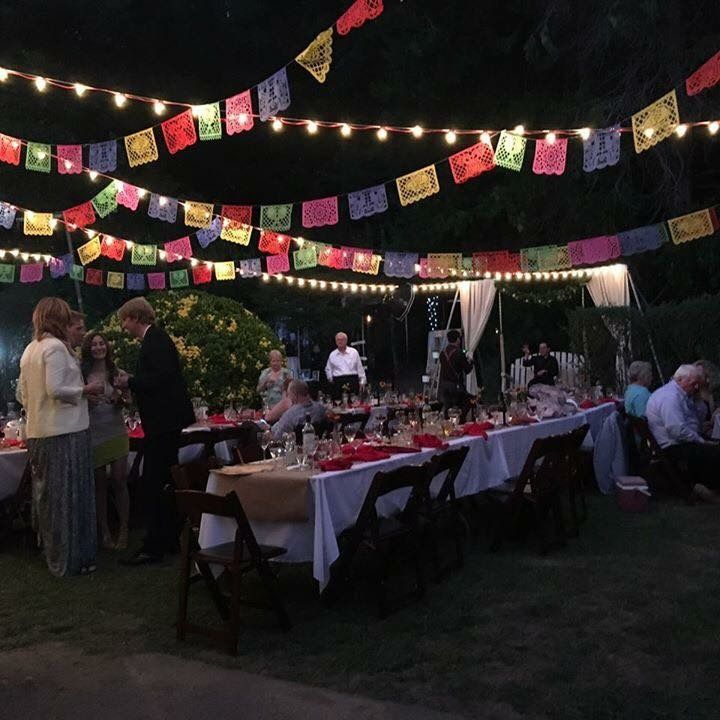
Strips of papel picado strung across overhead beams or fences add dynamic energy and movement to Mexican patios. These perforated tissue flags, often seen during festivals like Día de los Muertos or Cinco de Mayo, flutter in the breeze and inject immediate joy into any setting. Available in vivid colors such as fuchsia, turquoise, orange, and lime, they become instant mood-lifters that cost little yet deliver big on impact. When hung above dining zones, lounge areas, or garden walkways, the cutout patterns filter sunlight in playful ways. Some versions are weather-resistant, allowing for year-round display in outdoor spaces. Attaching them at varying lengths creates a cascade effect, heightening visual interest and depth. Mixing in LED string lights or bulb garlands further amplifies their nighttime charm. Homeowners often coordinate the paper designs with table linens, cushions, or planter hues for cohesive styling. Easy to swap out and store, these banners are perfect for themed gatherings or seasonal refreshes. Their lightweight nature means installation takes minutes, yet the effect lasts all evening. For patios craving color without heavy investment, papel picado serves as a charming, culturally rich solution that feels both festive and heartfelt.
Rustic Wooden Table with Talavera Centerpieces

Rustic wooden tables ground the dining zone with earthy charm, especially when accented by Talavera tile centerpieces. These brightly colored ceramics—ranging from serving trays to vases and bowls—bring bold pattern and Mexican folklore right to the table’s heart. The contrast between weathered wood grain and glossy tilework creates instant character, making every gathering feel warm and intentional. Many homeowners choose long farmhouse-style tables paired with mix-and-match chairs for a casual yet inviting vibe. Table runners in serape or Otomi prints add softness, while terracotta plates or handblown glassware reinforce the regional aesthetic. This setup works beautifully under pergolas or tree-shaded nooks, offering a space where meals extend into conversation. Whether used daily or reserved for festive weekends, the table becomes a cultural anchor. Positioning potted herbs or cacti alongside the centerpieces adds texture without overwhelming the layout. For evening ambiance, lanterns or candles nestled among the tiles cast a soft glow that highlights every detail. These dining setups celebrate craftsmanship, hospitality, and storytelling, transforming simple meals into memorable moments rooted in tradition and artistry.
Colored Glass Lanterns Hung at Varying Heights
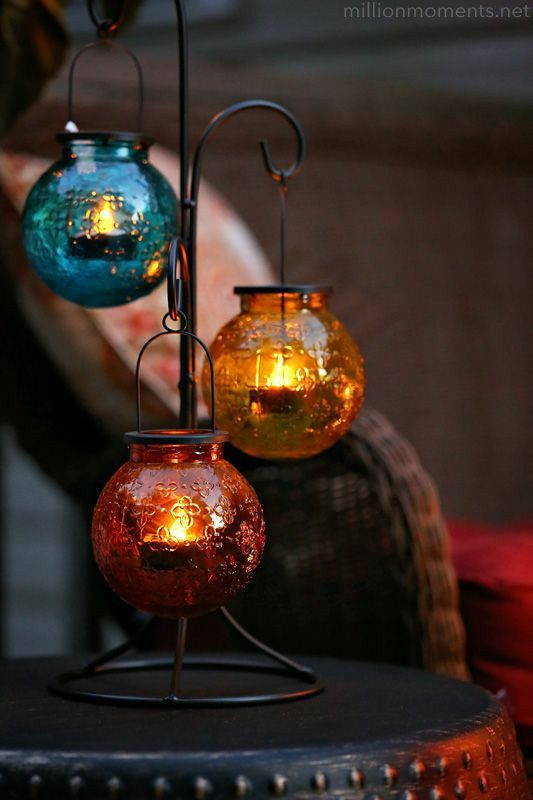
Suspended lanterns made of colored glass create layers of visual texture and glowing ambiance above Mexican patios. Each piece refracts light through tints of ruby, sapphire, emerald, or amber, casting jewel-toned reflections onto the surrounding walls and floor. Hanging them at staggered heights adds dimension and charm, especially over seating clusters or dining areas. These lanterns often feature wrought-iron frames with floral cutouts or mosaic glass panels, drawing from traditional Mexican metalwork. When lit at dusk, they turn an ordinary evening into something magical. Placing them above rustic tables or near garden pathways helps define space while avoiding harsh lighting. Many homeowners opt for solar-powered or battery-operated versions for ease of use. Combining various sizes—globes, teardrops, or star shapes—enhances the eclectic look and feels authentic to Mexico’s layered design approach. During the daytime, the colored glass adds a decorative accent even without illumination. For special occasions, these lanterns pair beautifully with papel picado or floral garlands to heighten the festive tone. This lighting choice brings function, color, and emotion together in one effortless design feature, offering a timeless solution for making patios feel as lively after sunset as they are by day.
Frida-Inspired Mural Backdrop with Seating Zone
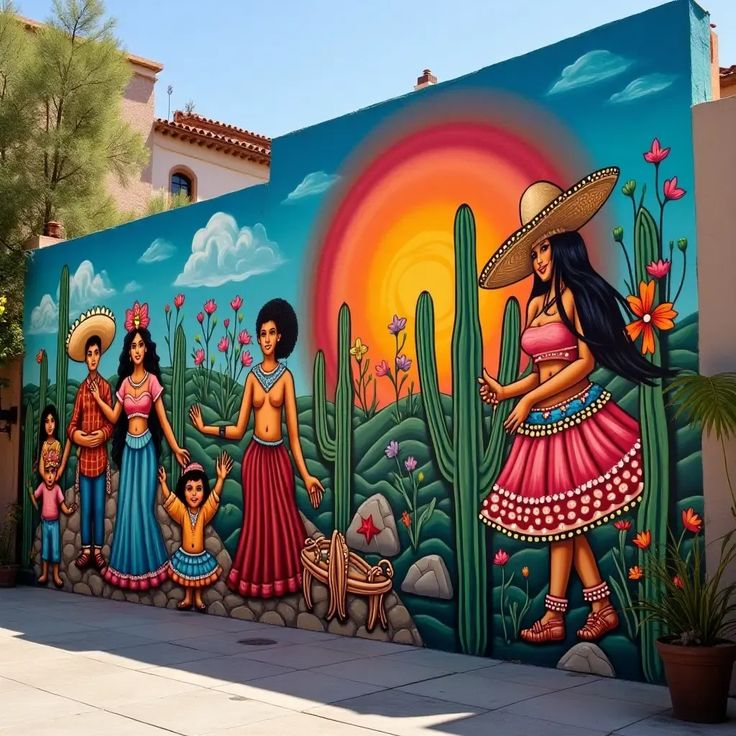
Walls turn into storytelling canvases when a mural inspired by Frida Kahlo anchors a patio lounge. Whether it’s a full-color portrait or symbolic floral-and-folklore mashup, this visual centerpiece adds emotional depth and vibrant identity. The mural may feature Kahlo’s signature unibrow, lush tropical motifs, or stylized parrots and monkeys—elements pulled from her iconic works. Positioned behind a seating area with woven or wooden benches, the artwork invites pause and contemplation. Homeowners often coordinate surrounding accents like embroidered cushions, rustic plant stands, and low tables to echo the mural’s color palette. This setup works especially well in enclosed patios or privacy-walled yards where the mural remains uninterrupted. Durable outdoor paints or tile mosaics can ensure longevity against weather exposure. Lighting placed to the side or above the mural enhances its visibility and impact during evening hours. Beyond aesthetics, a Frida-inspired mural pays homage to resilience, creativity, and personal expression—core values that resonate deeply in Mexican culture. It’s a bold design choice that turns lounging areas into immersive cultural experiences while serving as an evergreen conversation starter.
Mini Water Fountain with Tile Inlay Feature
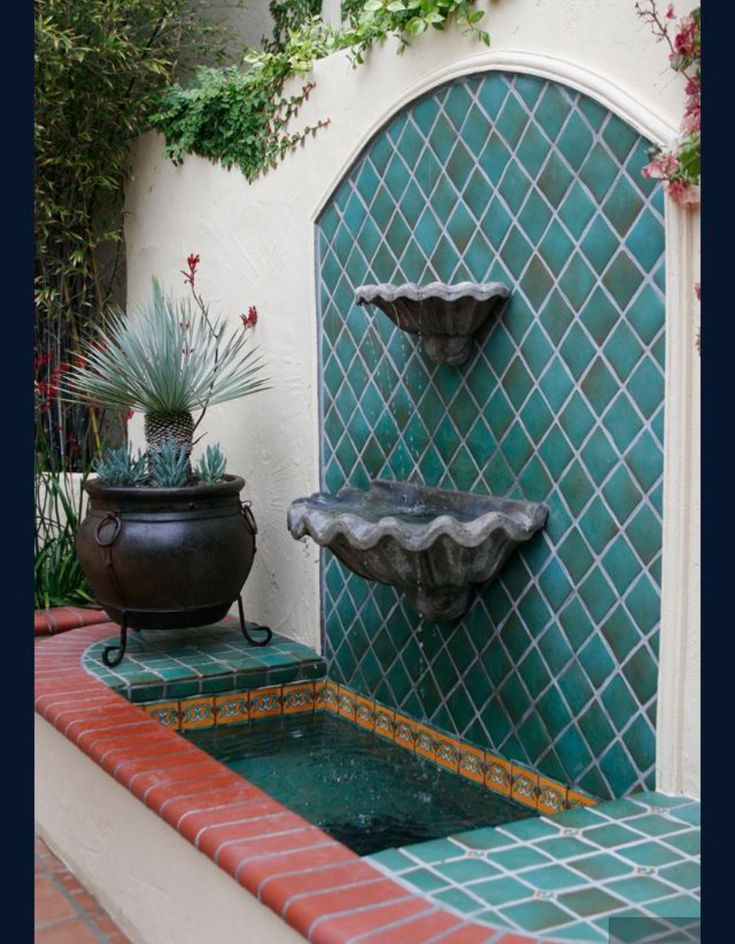
The sound of trickling water and hand-laid tilework merge seamlessly in a miniature patio fountain. These compact water features often serve as focal points in Mexican-inspired outdoor spaces, combining both motion and ornamentation. At the base, traditional Talavera or painted ceramic tiles frame the structure, while a small spout sends water bubbling into a shallow basin. The continuous flow offers a soothing audio backdrop that muffles nearby noise, making the patio feel more serene. Many of these fountains are freestanding and lightweight, allowing flexible placement near seating zones, planters, or entryways. The tile inlay—typically in blues, yellows, and terracotta tones—adds a strong visual anchor and nods to artisan tradition. Homeowners may choose solar-powered pumps for eco-efficiency and simple maintenance. To complete the setting, surrounding the fountain with pebbles, succulents, or low-voltage lighting enhances both form and function. Even the smallest patios benefit from the sensory richness it brings—sound, movement, and visual texture in one cohesive piece. Whether part of a meditative corner or festive courtyard, a tiled mini water feature provides a tranquil pulse that ties together the entire outdoor experience.
